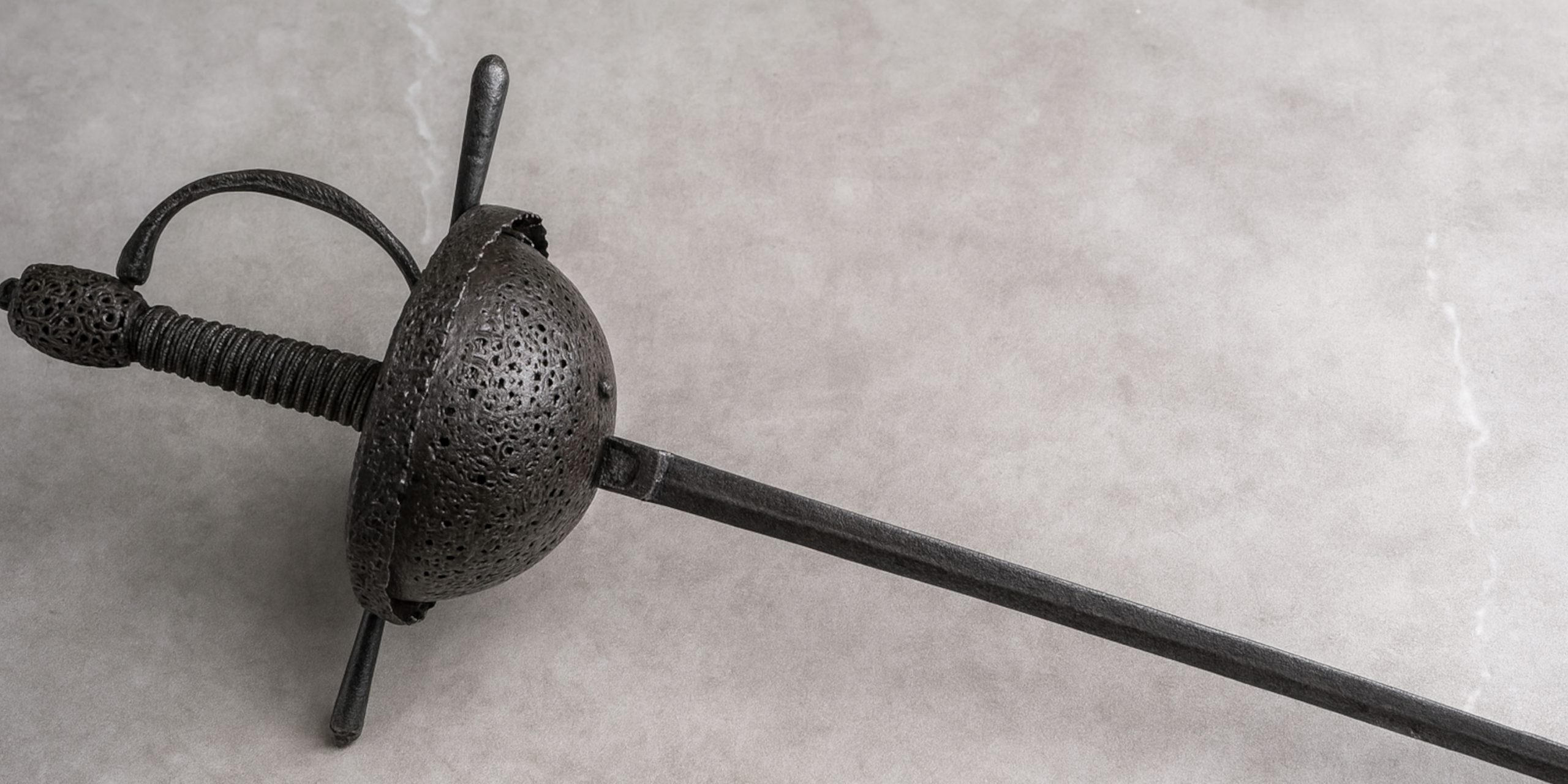
The cup hilt rapier is a distinctive European thrusting sword that emerged in the early 17th century. Associated with Spanish and Italian fencing traditions, it became a popular civilian weapon for duelling and self-defence during the Baroque period. Its defining feature is a concave, cup-shaped guard that offered superior hand protection while allowing fine control of the blade. This rapier type epitomised the fusion of practicality and elegance in sword design.
Specification
| Feature | Detail |
|---|---|
| Blade Length | 90 to 110 cm |
| Overall Length | 105 to 125 cm |
| Blade Type | Narrow, double-edged or single-edged |
| Grip | Wood or horn, often wire-bound |
| Guard Type | Cup-shaped, solid or pierced metal |
| Pommel | Globular or faceted |
| Weight | 1.1 to 1.4 kg |
| Balance Point | Approximately 10 cm from the guard |
History and Evolution
The cup hilt rapier developed around 1610, largely in Spain and southern Italy, as a response to the limitations of earlier swept-hilt and complex-hilt rapiers. While those earlier types offered some hand protection, the cup hilt provided a much more complete barrier without impeding manoeuvrability.
Early examples were typically plain, with solid iron or steel cups. As the weapon became associated with status and duelling culture, it evolved to include pierced, engraved, or silver-inlaid cups. Spanish fencing manuals such as La Verdadera Destreza often illustrated cup hilts, reinforcing their role in formalised civilian combat.
By the late 17th century, as smallswords began to dominate aristocratic circles and military sabres took precedence in the field, the cup hilt remained in ceremonial use, particularly in Spanish territories and colonial holdings well into the 18th century.
Advantages and Disadvantages
Advantages:
- Superior hand protection without excessive weight
- Balanced thrusting performance
- Ideal for duelling and formalised fencing
- Visually impressive and easily customisable
Disadvantages:
- Less effective for cutting than broader blades
- Cumbersome in confined spaces compared to smallswords
- Difficult to carry discreetly
- Expensive to produce, especially ornamental variants
Comparison with Similar Weapons
| Feature | Cup Hilt Rapier | Swept-Hilt Rapier | Smallsword |
|---|---|---|---|
| Blade Width | Narrow | Medium | Very narrow |
| Guard Protection | Full hand (cup) | Partial (bars & rings) | Minimal (shell or disc) |
| Primary Use | Thrusting duels | Thrust and cut fencing | Court duelling |
| Manoeuvrability | Moderate | High | Very high |
| Cultural Centre | Spain & Italy | Italy, France, Germany | France & Britain |
| Period of Use | 1610 to 1750 | 1550 to 1650 | 1700 to 1800 |
Legacy
The cup hilt rapier remains one of the most iconic weapons of the Spanish Golden Age. Its close association with La Destreza and the formalised traditions of fencing schools secured its place as a symbol of martial discipline and noble conduct.
In modern historical fencing, the cup hilt is still studied and replicated, particularly within Spanish and Italian traditions. Its elegant silhouette has also made it a popular weapon in films and stage productions, often standing in for rapiers of various styles.
Where to See
Several museum collections house notable examples of cup hilt rapiers, including:
- Museo del Ejército, Toledo, Spain – Home to several 17th-century Spanish examples.
- Wallace Collection, London – Displays Italian and Spanish cup hilts.
- Kunsthistorisches Museum, Vienna – Features elaborately decorated ceremonial rapiers.
- Metropolitan Museum of Art, New York – Holds pieces with both practical and ornate designs.
Collectors Guide and Auction Prices
Collectability:
- Highly sought after by collectors of European arms, especially those specialising in duelling or Spanish weaponry.
- Value increases with craftsmanship, provenance, and condition.
- Pierced or gilded cups fetch higher prices.
Auction Prices:
| Example Type | Typical Price Range |
|---|---|
| Plain 17th-century example | £3,000 to £6,000 |
| Decorated or pierced variant | £7,000 to £15,000 |
| Noble or courtly provenance | £15,000 to £40,000+ |
| Reproductions (modern) | £300 to £1,200 |
Collectors should verify authenticity and ensure any restoration work is clearly documented. Provenance, especially if linked to a fencing master or noble house, significantly boosts both interest and market value.
The cup hilt rapier stands as a symbol of the high art of swordsmanship and the craftsmanship of Baroque Europe. It remains a testament to a time when form and function met in the crucible of ritualised combat and personal honour.
Watch the review:



